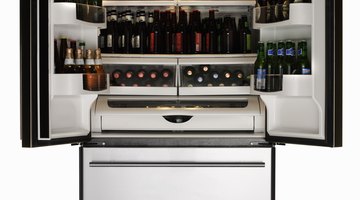How Does Radiation Work in a Refrigerator?
The modern household would fall into chaos without a fridge. Nearly every home in the Western world relies on them to safely store meat, dairy products, salads, fresh fruit and cold beers.

The older generation may recall life before the fridge, but for the younger generation, their steady hum and reassuring presence is a simple fact of life. Yet, without producing a certain amount of radiation, fridges would not function at all.
The Story of the Fridge
The size and technology of early fridges made them far too expensive for the average household, and they were mainly used for commercial purposes. The poisonous ammonia gas which was used as a coolant in the first fridges was later replaced by chlorofluorocarbon (CFC). In 1927, General Electric made the design of fridges smaller and the technology more cost-effective. It was a massive breakthrough, and by the 1930s it was estimated that 60 percent of American homes had a fridge.
How a Fridge Works
Refrigerators slow down the growth and reproduction of microorganisms which cause food to rot. Old fridges use CFC gas, which is pumped in a perpetual cycle by an electric motor into the coils of the fridge. Here the CFC absorbs the heat and keeps everything nice and cool. Because CFCs are harmful to the atmosphere if released, modern refrigerators use a gas called HFC, also known as tetrafluoroethane. When the temperature in the fridge reaches its desired setting, a device called a thermocouple shuts off the electricity which enables the fridge to function. The electromagnetic fields which the fridge generates are a source of its radiation.
Electromagnetic Radiation
Many modern appliances emit electromagnetic fields (EMFs). Seen by some as the dark side of technology and the price of convenience, EMFs are invisible and emanate outwards, affecting everything in their vicinity. They occur every time you switch on a mains-powered device and activate the electrical current. The degree of voltage dictates the intensity of the EMFs which interact to produce electromagnetic radiation (EMR). Spreading outwards from its source, EMR travels at the speed of light. Refrigerators emit low EMR, and are considered safe when used correctly, but if there is a malfunction they are considered a safety hazard.
Are Fridges Harmful?
Modern fridges use about one-tenth of the electricity of their predecessors. They are more environmentally friendly and produce less radiation. Any appliance which feeds on a continual electrical current poses risks. However, anyone who grabs a cold beer from the fridge on a hot afternoon will probably find those risks are well worth taking.
The Drip Cap
- The modern household would fall into chaos without a fridge.
- The older generation may recall life before the fridge, but for the younger generation, their steady hum and reassuring presence is a simple fact of life.
- Refrigerators slow down the growth and reproduction of microorganisms which cause food to rot.
- Seen by some as the dark side of technology and the price of convenience, EMFs are invisible and emanate outwards, affecting everything in their vicinity.
- The degree of voltage dictates the intensity of the EMFs which interact to produce electromagnetic radiation (EMR).
References
Photo Credits
- Ryan McVay/Photodisc/Getty Images
- Ryan McVay/Photodisc/Getty Images
More Articles



